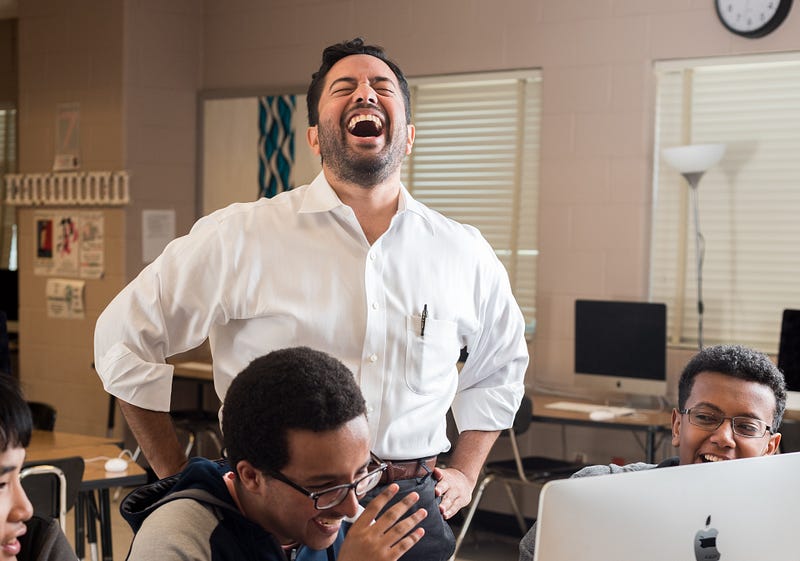What Happens When You Flip Your Classroom?
Instruction for homework? Homework for instructional time? What’s up with the flipped classroom?

Samir Paul teaches computer science in Montgomery County where he was named 2016’s Rising Star Teacher of the Year.
He is also co-chair of the the Montgomery County Education Association Government Relations Committee.
The idea of a flipped classroom is simple enough: record (or curate) video lectures to shift direct instruction outside of the classroom, and spend time in the classroom doing what would otherwise have been considered “homework.”
I had dipped my toes in a few years earlier while teaching Algebra II repeaters at a Title I high school in DC, and I had gotten some positive feedback. Truancy was such a problem in that environment that I was running myself ragged teaching and re-teaching the same lessons weeks after we had covered them in a whole-class setting. Though I first came to video lectures as a way to reduce my overall workload and create resources to support limited-literacy students, the years since have shown me that the flipped classroom can be a powerful tool freeing educators to spend more time doing what they do best.
How it works
Each night, my computer science students watch a 5 to 20-minute video — a narrated slideshow interspersed with some screencasts of my computer as I write and run computer programs. While they watch and take notes, YouTube annotations reveal a few short codes, which students record for later.
After they finish, they go to my class website and complete a Google form that asks which lecture they just viewed and what its pop-up codes were. More importantly, though, the form asks for:
- A “tweet” summarizing the video;
2. Confusing or unclear points;
3. Concrete questions that can seed discussion in class; and
4. What mistakes I made that demand correction.
Late that night or early the next morning, I scan through the students’ submissions and prepare a counter-presentation for the next day. After some chit-chat at the beginning of class, I launch into the slides and try to press the boundaries of their understanding. Once everyone is satisfied, we take a short quiz (meant solely as an accountability measure), then launch into 40–60 minutes of unstructured work time. Students have a week-long, college-style problem set that applies organically what they have been learning in class
Why flip your classroom?
Flipped classrooms give students control over their own pace of consumption. They can watch me at regular speed or at 2x or, if they’re already confident about this topic, they can roll the dice and skip a lecture at their own risk. They can rewind, re-watch, and skip ahead as they’d like. Students don’t have to feel self-conscious about consuming new material slowly, nor do they have to feel the boredom of waiting for the rest of the class to catch up when they are ready to press on. And because students submit initial questions asynchronously, I can elevate the voices and insightful contributions of girls who — for whatever reason — might not otherwise have spoken up in a live-fire STEM classroom setting.
“Students don’t have to feel self-conscious about consuming new material slowly, nor do they have to feel the boredom of waiting for the rest of the class to catch up when they are ready to press on.”
Video lessons are also more consistent and denser than live lessons, because I splice together the best possible version of each lecture and then edit it down considerably. I can tighten a 20-minute live lecture into nine or ten minutes on video. Kids will watch a 10-minute lecture without complaint, but I’ve actually packed in the content of a far longer live lesson.
This model also clears more time in class for the things that a real, live human teacher does best — interactive discussion and questioning as opposed to dry lecture. It’s not that my students come in and immediately get to work at their computers, rather, we’ve leapfrogged the traditional first 20 minutes of the class during which I would have been introducing new material and vocabulary.
We jump right to questioning-focused pedagogy during which I can probe for misunderstandings and press them to go deeper. Because they’re still fresh at the start of class, I get their best efforts on the part of the lesson I care most about.

The flipped classroom model enshrines work time, when students actually have long stretches to make progress on their problem sets under my guidance. They’re often seen working in pairs or trios to vault over a challenging task. And, I’ve found that I can assign especially tough problems because I know that I’ll be in the room to inject just the right oblique guidance, sending a student in the right direction without giving away an answer.
At home, a student might have beaten her/his head against the wall for hours before giving up. Best to head off the wailing and gnashing of teeth as swiftly as possible.
Why I’m now a skeptic, too
The flipped classroom might not be a solution for everyone, and I’m not even totally sure it’s still the best solution for me. First and foremost, high-quality curricular materials take a life-ruining amount of time to produce. The up-front investment is massive: Between research, slide creation, recording, and editing, a single 10-minute video takes me two or three hours to produce. That’s a daunting buy-in. And the videos need to be high-quality. Some teachers subscribe to a school of thought that a five-minute video should take five minutes to record, but I find that students are sensitive to dips in quality and are much more likely to take seriously materials that look and feel professional. You do get to reap the benefits for years afterward, but if you’re committed to making the model work full-time from day one, prepare for a bruising year.
Decentralizing the academic experience and allowing students to control their own pace sounds good, but it also makes the logistics of a class much more difficult. If students don’t watch a lecture the night before, then you either have to re-deliver it live or let them watch it during class time, giving up the benefits of the model. And if students get ahead or fall behind, they can wind up having a significantly less unified academic experience.
That matters, because learning is a fundamentally social activity. For thousands of years, young people have learned with others, and I blanch at “innovations” that shake this basic fact about the way kids develop. There is something special about experiencing a new idea for the first time with a room full of other people — something electric that is hard to capture if everyone has already seen the big idea independently and you’re just fine-tuning it as a group.
Sometimes, during work time, I used to interpret pin-drop silence and 100% engagement in my classroom as the sign that I had done something right and had designed an activity that gave every student an entry point and a path forward regardless of her/his level of prior knowledge.
“A flipped classroom can never replace the special magic that a skilled teacher can conjure at the whiteboard, pin-pricking students’ brains for the first time with a brand new idea.”
Now, that mostly makes me nervous. Why isn’t anyone talking about anything? Why isn’t anyone laughing? Why isn’t anyone asking anyone else for help? I’ve played a lot with the flipped classroom structure over the past few years and it has yielded plenty of impressive benefits. But it can never replace the special magic that a skilled teacher can conjure at the whiteboard, pin-pricking students’ brains for the first time with a brand new idea.
The flipped classroom, I think, is best viewed not as a revolutionary pedagogical model but rather as the 21st-century version of getting kids to read the textbook before coming to class. It’s about priming them to discuss an idea so that a skilled educator feels the freedom, time, and space to concoct an enriching, electrifying in-person intellectual-social experience.
Tech tips for a flipped classroom
Though I believe people get a little too caught up on the specific technologies I use to run my system, here goes: I use a $90 Samson C01U USB condenser microphone mounted with a pop filter to mitigate explosive consonants. I record and edit my videos using Camtasia Studio. I then upload them to my YouTube channel and post links on my class website, where I also host all the lecture slides and weekly problem sets.

